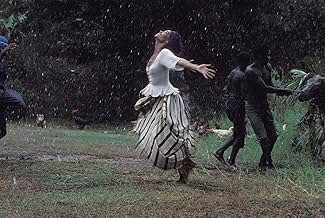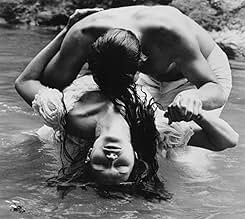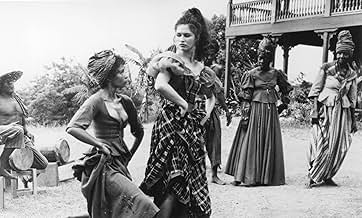NOTE IMDb
5,6/10
2,3 k
MA NOTE
Ajouter une intrigue dans votre langueIn 1840s Jamaica, a young female landowner marries an Englishman to keep her property. Their love blossoms, but she hides a childhood secret about her mother that threatens their relationshi... Tout lireIn 1840s Jamaica, a young female landowner marries an Englishman to keep her property. Their love blossoms, but she hides a childhood secret about her mother that threatens their relationship.In 1840s Jamaica, a young female landowner marries an Englishman to keep her property. Their love blossoms, but she hides a childhood secret about her mother that threatens their relationship.
- Réalisation
- Scénario
- Casting principal
Martine Beswick
- Aunt Cora
- (as Martine Beswicke)
Avis à la une
This movie takes a great, rich, wonderful novel and reduces it to the level of near soft porn. So much time is spent on silly, pointless nude scenes that the plot has to be severely condensed. Major plot points seem to happen suddenly, without context or explanation and characters are poorly developed And the nude scenes aren't even very good, they were just cheesy - after the second or third time Rochester and Antoinette stripped, I was laughing out loud.
The film has some great Jamaican locations, but that's about the only good thing I can say for it.
The film has some great Jamaican locations, but that's about the only good thing I can say for it.
Sumptuous-looking, beautifully photographed, meticulously produced....this movie seems to do everything right visually. But its story, very engaging in the first half, runs out of steam in the second. Story points and character motivations are often muddled, and I never got a complete and clear idea of where and when exactly the passionate love affair between the two basic characters started to go wrong. And yes, it is sometimes erotic (mostly thanks to the very beautiful Karina Lombard), but it never becomes as steamy as you may have heard. (**1/2)
I think that there seem to be some confusion expressed in a number of the reviews of this and a subsequent version of Jean Rhys' most famous novel. Just for information:
1. Creole does not necessarily imply mixed race. Bertha (to use Rochester's name for her) was clearly white enough to appear white and indeed, like Jean Rhys herself, may have been entirely of European ancestry. The mixed race brother, Daniel, was black on his mother's side which has nothing to do with Bertha's mother being mostly/entirely French. He was angry and destructive because his father preferred the white daughter to him.
2. The Wide Sargosso Sea is a sort of prequel but it is also a re-imagining of the back story for Jane Eyre that is intended to take Bertha's character and expand on it with Rhys inability to ever fully reconcile herself to the differences between her origins and life in Europe.
3. While we think of the Caribbean as a dominantly black environment, the origins were Carib Indian and whites colonized the area before the introduction of African slaves. The racial undertone is a more modern view than Bronte likely had. She was trying to deal with the whole idea of foreignness/strangeness and the ultimate solution to the plight of Jane's situation, poor but of "gentle" birth.
4. Of the two filmed versions, the first makes the characters too physically attractive and really misses the novel's stress on the protagonists never meshing rather than loving and losing love.
5. One problem with the casting of Rochester in the first version is that the actor portraying Rochester is distractingly gorgeous and not sufficiently British (apart from his accent). In fact he looks like he rather fits in, in contrast to Bertha's uncle and the other European planters. Of course, the actress who portrays Bertha, even at the end, is so enticing that Rochester's loss of interest is inexplicable.
6. The first film seems to run out of time and rushes the end. Not enough is made of Rochester's anger at being manipulated, whether by voodoo, drugs or circumstances. Once he becomes his father's heir, the return to England should have led to something other than the conclusion. There is definitely insufficient deterioration in Bertha. Their stories are mirror images. He deteriorates and is miserable where she is able to live and she deteriorates where he is able to live.
7. The novels (both Jane Eyre and The Wide Sargosso Sea) have a great deal of narration which is lost in the earlier film and perhaps insufficient in the second. None of the films are substitutes for the books but all are interesting reimaginings.
8. In order to appreciate the Rhys novel, one should read about the author. The same is true of Jane Eyre and its author. The more things change, the more they stay the same.
Finally, while not great, the films both aspire to be literary, which means a lot in an age when filmmakers think there is a need for horror/splatter movies and lots of people apparently agree so I for one say thank you for both versions of the Wide Sargosso Sea and all of the versions of Jane Eyre that offer relief from the current tripe.
1. Creole does not necessarily imply mixed race. Bertha (to use Rochester's name for her) was clearly white enough to appear white and indeed, like Jean Rhys herself, may have been entirely of European ancestry. The mixed race brother, Daniel, was black on his mother's side which has nothing to do with Bertha's mother being mostly/entirely French. He was angry and destructive because his father preferred the white daughter to him.
2. The Wide Sargosso Sea is a sort of prequel but it is also a re-imagining of the back story for Jane Eyre that is intended to take Bertha's character and expand on it with Rhys inability to ever fully reconcile herself to the differences between her origins and life in Europe.
3. While we think of the Caribbean as a dominantly black environment, the origins were Carib Indian and whites colonized the area before the introduction of African slaves. The racial undertone is a more modern view than Bronte likely had. She was trying to deal with the whole idea of foreignness/strangeness and the ultimate solution to the plight of Jane's situation, poor but of "gentle" birth.
4. Of the two filmed versions, the first makes the characters too physically attractive and really misses the novel's stress on the protagonists never meshing rather than loving and losing love.
5. One problem with the casting of Rochester in the first version is that the actor portraying Rochester is distractingly gorgeous and not sufficiently British (apart from his accent). In fact he looks like he rather fits in, in contrast to Bertha's uncle and the other European planters. Of course, the actress who portrays Bertha, even at the end, is so enticing that Rochester's loss of interest is inexplicable.
6. The first film seems to run out of time and rushes the end. Not enough is made of Rochester's anger at being manipulated, whether by voodoo, drugs or circumstances. Once he becomes his father's heir, the return to England should have led to something other than the conclusion. There is definitely insufficient deterioration in Bertha. Their stories are mirror images. He deteriorates and is miserable where she is able to live and she deteriorates where he is able to live.
7. The novels (both Jane Eyre and The Wide Sargosso Sea) have a great deal of narration which is lost in the earlier film and perhaps insufficient in the second. None of the films are substitutes for the books but all are interesting reimaginings.
8. In order to appreciate the Rhys novel, one should read about the author. The same is true of Jane Eyre and its author. The more things change, the more they stay the same.
Finally, while not great, the films both aspire to be literary, which means a lot in an age when filmmakers think there is a need for horror/splatter movies and lots of people apparently agree so I for one say thank you for both versions of the Wide Sargosso Sea and all of the versions of Jane Eyre that offer relief from the current tripe.
Jean Rhys has taken seven years to finish the novel, on which the movie is supposed to be based on. However, this rated film seems to be only concentrating on the sexual relationship between Rochester and Antoinette, as well as Sandi and Antoinette. The relationship with Sandi is deliberately kept as question marks for readers to ponder upon in the novel, but here in the movie it is explicitly interpreted and the sympathy created by Rhys is lost. But the movie is nevertheless a representation of colors in the Caribbeans--red, purple, blue and green--the exotic side of life that has repeled Rochester.
The following review is taken from my contribution to a thread called "Worst novel adaptations" from the Film General board: Wide Sargasso Sea was originally a beautiful, haunting novel set in mid-19th century Jamaica written by Creole-Welsh writer Jean Rhys in the 1960s. Plot-wise, it's basically the prequel to Charlotte Bronte's Jane Eyre, the story of a young Mr Rochester traveling to the Caribbean and meeting his first wife, the "mad wife" in the attic featured in Jane Eyre (though here she is young and not yet "mad", and we are described what gradually led her to losing her sanity). It's a sensual novel, mainly because the lush Jamaican countryside and emotional spontaneity of the local people was too much for the straight-laced, English Victorian gent, Rochester. But there are no sex scenes in the novel - basically, it's NOT an erotic novel as the film "adaptation" would suggest. It's written in subtle, understated yet powerfully-evoked prose that speaks of the movements of the soul rather than those of the pelvis. There's lots of passion in Wide Sargasso Sea THE BOOK, but it's mostly emotional. It's an extremely multi-layered novel and the work of a true master. The film on the other hand is just your classic, bad 1990s film, beautiful to look at, with lots of skin, languid copulation, heaving bosoms, bodice-ripping nonsense, etc and next to no substance. It has no artistic integrity whatsoever, as its shameless makers must surely know they lifted their middle finger at the spirit of the Jean Rhys novel when choosing to make the film the way they did. None of the understanding of the deepest secrets of the soul that the novel can so miraculously evoke. None of the beauty, poetry, deep, heart-felt tragedy, pathos, haunting quality. Nothing. Just a lot of pointless, choreographed sex between beautiful people in an "exotic" setting. Why not make an erotic version of Jane Eyre while we're at it? Plus there's nothing worse than eroticism that takes itself too seriously. I'd highly recommend the novel by the way: a book you don't forget in a hurry. Needless to say I think you should give this insulting (to the memory of Jean Rhys) film a miss, especially if you've read the novel: it'll just frustrate you, no matter how keen on a bit of easy titillation you may be feeling at the time.
Le saviez-vous
- AnecdotesThe picture was classified and rated with a restricted NC-17 rating in the USA due to its explicit sexual content. Distributor Fine Line Features decided not to appeal the decision in order to try and gain a lower classification rating to make the movie marketable and able for younger audiences to attend. The New York Times reported "Fine Line Features, the art-film division of New Line Cinema, has accepted the rating for 'Wide Sargasso Sea (1993)' which includes male frontal nudity".
- Citations
Edward Rochester: England seems far away.
- Versions alternativesEdited, R-rated version available on video.
Meilleurs choix
Connectez-vous pour évaluer et suivre la liste de favoris afin de recevoir des recommandations personnalisées
- How long is Wide Sargasso Sea?Alimenté par Alexa
Détails
Box-office
- Budget
- 4 500 000 $US (estimé)
- Montant brut aux États-Unis et au Canada
- 1 614 784 $US
- Week-end de sortie aux États-Unis et au Canada
- 33 806 $US
- 18 avr. 1993
- Montant brut mondial
- 1 614 784 $US
- Durée1 heure 39 minutes
- Couleur
- Rapport de forme
- 1.85 : 1
Contribuer à cette page
Suggérer une modification ou ajouter du contenu manquant
































